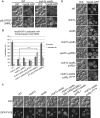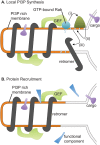Rab5-family guanine nucleotide exchange factors bind retromer and promote its recruitment to endosomes
- PMID: 25609093
- PMCID: PMC4357511
- DOI: 10.1091/mbc.E14-08-1281
Rab5-family guanine nucleotide exchange factors bind retromer and promote its recruitment to endosomes
Erratum in
-
Correction.Mol Biol Cell. 2015 Apr 1;26(7):1411. Mol Biol Cell. 2015. PMID: 25823929 Free PMC article. No abstract available.
Abstract
The retromer complex facilitates the sorting of integral membrane proteins from the endosome to the late Golgi. In mammalian cells, the efficient recruitment of retromer to endosomes requires the lipid phosphatidylinositol 3-phosphate (PI3P) as well as Rab5 and Rab7 GTPases. However, in yeast, the role of Rabs in recruiting retromer to endosomes is less clear. We identified novel physical interactions between retromer and the Saccharomyces cerevisiae VPS9-domain Rab5-family guanine nucleotide exchange factors (GEFs) Muk1 and Vps9. Furthermore, we identified a new yeast VPS9 domain-containing protein, VARP-like 1 (Vrl1), which is related to the human VARP protein. All three VPS9 domain-containing proteins show localization to endosomes, and the presence of any one of them is necessary for the endosomal recruitment of retromer. We find that expression of an active VPS9-domain protein is required for correct localization of the phosphatidylinositol 3-kinase Vps34 and the production of endosomal PI3P. These results suggest that VPS9 GEFs promote retromer recruitment by establishing PI3P-enriched domains at the endosomal membrane. The interaction of retromer with distinct VPS9 GEFs could thus link GEF-dependent regulatory inputs to the temporal or spatial coordination of retromer assembly or function.
© 2015 Bean et al. This article is distributed by The American Society for Cell Biology under license from the author(s). Two months after publication it is available to the public under an Attribution–Noncommercial–Share Alike 3.0 Unported Creative Commons License (http://creativecommons.org/licenses/by-nc-sa/3.0).
Figures







Similar articles
-
The VINE complex is an endosomal VPS9-domain GEF and SNX-BAR coat.Elife. 2022 Aug 8;11:e77035. doi: 10.7554/eLife.77035. Elife. 2022. PMID: 35938928 Free PMC article.
-
Ubiquitin binding by the CUE domain promotes endosomal localization of the Rab5 GEF Vps9.Mol Biol Cell. 2015 Apr 1;26(7):1345-56. doi: 10.1091/mbc.E14-06-1156. Epub 2015 Feb 11. Mol Biol Cell. 2015. PMID: 25673804 Free PMC article.
-
Vps9 family protein Muk1 is the second Rab5 guanosine nucleotide exchange factor in budding yeast.J Biol Chem. 2013 Jun 21;288(25):18162-71. doi: 10.1074/jbc.M113.457069. Epub 2013 Apr 23. J Biol Chem. 2013. PMID: 23612966 Free PMC article.
-
Multiple Roles of VARP in Endosomal Trafficking: Rabs, Retromer Components and R-SNARE VAMP7 Meet on VARP.Traffic. 2016 Jul;17(7):709-19. doi: 10.1111/tra.12406. Epub 2016 May 13. Traffic. 2016. PMID: 27103185 Review.
-
Unveiling the cryo-EM structure of retromer.Biochem Soc Trans. 2020 Oct 30;48(5):2261-2272. doi: 10.1042/BST20200552. Biochem Soc Trans. 2020. PMID: 33125482 Free PMC article. Review.
Cited by
-
Identification of a Rab GTPase-activating protein cascade that controls recycling of the Rab5 GTPase Vps21 from the vacuole.Mol Biol Cell. 2015 Jul 1;26(13):2535-49. doi: 10.1091/mbc.E15-02-0062. Epub 2015 May 13. Mol Biol Cell. 2015. PMID: 25971802 Free PMC article.
-
Regulation of early endosomes across eukaryotes: Evolution and functional homology of Vps9 proteins.Traffic. 2018 Jul;19(7):546-563. doi: 10.1111/tra.12570. Epub 2018 Apr 25. Traffic. 2018. PMID: 29603841 Free PMC article.
-
Vps21 Directs the PI3K-PI(3)P-Atg21-Atg16 Module to Phagophores via Vps8 for Autophagy.Int J Mol Sci. 2022 Aug 23;23(17):9550. doi: 10.3390/ijms23179550. Int J Mol Sci. 2022. PMID: 36076954 Free PMC article.
-
A conserved and regulated mechanism drives endosomal Rab transition.Elife. 2020 May 11;9:e56090. doi: 10.7554/eLife.56090. Elife. 2020. PMID: 32391792 Free PMC article.
-
Receptor Recycling by Retromer.Mol Cell Biol. 2023;43(7):317-334. doi: 10.1080/10985549.2023.2222053. Epub 2023 Jun 23. Mol Cell Biol. 2023. PMID: 37350516 Free PMC article. Review.
References
-
- Attar N, Cullen PJ. The retromer complex. Adv Enzyme Regul. 2010;50:216–236. - PubMed
-
- Babu M, Vlasblom J, Pu S, Guo X, Graham C, Bean BDM, Burston HE, Vizeacoumar FJ, Snider J, Phanse S, et al. Interaction landscape of membrane-protein complexes in Saccharomyces cerevisiae. Nature. 2012;489:585–589. - PubMed
-
- Balderhaar H, Arlt H, Ostrowicz C, Brocker C, Sundermann F, Brandt R, Babst M, Ungermann C. The Rab GTPase Ypt7 is linked to retromer-mediated receptor recycling and fusion at the yeast late endosome. J Cell Sci. 2010;123:4085–4094. - PubMed
Publication types
MeSH terms
Substances
Grants and funding
LinkOut - more resources
Full Text Sources
Molecular Biology Databases
Research Materials

